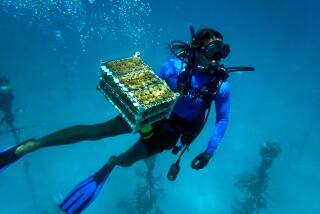Meet the tiny fish that have a huge effect on coral reef ecosystems
It’s one of the enduring mysteries of marine biology: How can coral reefs sustain such diverse ecosystems when they are surrounded by clear, low-nutrient waters? Now scientists think they’ve found the answer, and it’s been hiding in plain sight all along.
The coral reef food chain is powered by some of the ocean’s smallest vertebrates — tiny fish that are gobbled up so quickly they’ve been easy to overlook.
These fish are small enough to fit in the palm of your hand, but they play an almost heroic role in sustaining coral reefs, according to a study published this month in the journal Science. In fact, these little swimmers account for almost 60% of the fish flesh eaten on reefs, researchers found.
“They’re really like high-octane fuel for larger fish,” said study leader Simon Brandl, a marine ecologist at Simon Fraser University in Burnaby, Canada.
He likened them to sushi served on a conveyor belt in Japanese restaurants: “Almost as soon as that plate is put on the conveyor belt, it gets eaten.”

The survival of coral reef ecosystems relies on seldom-seen, historically overlooked cryptobenthic reef fishes – the smallest of marine vertebrates. (Video by Simon Brandl, Music by Carlos Estella)
Bob Richmond, a marine biologist at the University of Hawaii at Manoa who was not involved in the study, said that understanding the contributions of these short-lived fish is critical.
“They may be small, but they’re mighty,” he said.
Coral reefs are like underwater rain forests — they’re incredibly diverse and are home to more than 6,000 species of fish, Brandl said.
Yet the nutrients needed to maintain this abundance of life seemed to be lacking. Scientists even have a name for this conundrum: Darwin’s paradox.
Researchers have theorized that reefs draw sustenance from currents that bring in nutrient-rich water from the depths of the ocean, or from zooplankton that drift into the reef from the sea. Another possibility is that reefs are unusually efficient at recycling the nutrients that are in their habitat already.
But Brandl and his colleagues make a strong case that high turnover of tiny fish is an important part of the story, said Douglas McCauley, a marine biologist at UC Santa Barbara who did not work on the study.
“The reefs are not made possible solely because of these tiny fish, but they are more important than we thought,” McCauley said.
Measuring less than 2 inches in length and weighing less than one-hundredth of an ounce, on average, the roughly 2,800 species of so-called cryptobenthic fish make up almost half of all coral reef fish species. A typical reef has 15 to 20 of these tiny fish per square meter, Brandl said.
Despite their colorful appearance, the fish are good at blending in with their backgrounds (that’s where the “crypto” in cryptobenthic comes from). Many try to hide in a reef’s nooks and crannies, but that works for only so long. Up to 70% of them are eaten every week, and most species live no longer than several months.
The tiny fish hatch from eggs, and within a day or so, the larvae are old enough to find their own food. Then they have to grow up and reproduce within a month or two — before they get eaten. They spent two to three weeks as larvae outside the reef and then have a few weeks to become sexually mature once they return to the reef.
“They’re growing, growing, growing — dead,” said Luke Tornabene, a fish biologist at the University of Washington in Seattle who worked on the study. “It’s a race to sexual maturity.”
And when they get there, the females have another problem to contend with: low egg counts. Their small bodies can produce only about 100 eggs at a time, on average, while larger fish may lay tens or hundreds of thousands.
“It didn’t seem to add up,” said senior author David Bellwood, a marine biologist at James Cook University in Townsville, Australia. “How on Earth did they survive?”
In a word: larvae.The scientists reviewed previously published data and calculated that about two-thirds of the larvae living within 5 kilometers (about 3 miles) of a reef were members of these small species.
“If they didn’t have this big reservoir of new recruits of larvae that could replenish each adult that gets eaten on the reef, their populations would take a nose dive immediately,” Brandl said.
While the larvae of most coral reef fish wander out into the open ocean to escape predators on reefs, the larvae of cryptobenthic fish hang out near the reef as they mature. This seems to dramatically enhance their survival and return rates, Brandl said.
The researchers then created a model of the fish population dynamics on a reef. Sure enough, they found that the abundance of cryptobenthic fish larvae made it possible for these species to survive even though so many of their adults were eaten so quickly. According to their model, nearly 58% of fish flesh eaten on a reef came from tiny fish.
It may seem surprising that scientists didn’t know where more than half of the fish food supply was coming from, but at any given moment, the tiny fish make up only a minuscule percentage of the total fish flesh on a reef. The key was to see that the population replenished itself so quickly, Tornabene said.
“That really was the piece that’s missing,” he said.





